

Compact Muon Solenoid
LHC, CERN
| CMS-PAS-HIN-15-015 | ||
| Measurement of the charged particle nuclear modification factor in PbPb collisions at √sNN= 5.02 TeV | ||
| CMS Collaboration | ||
| May 2016 | ||
| Abstract: The nuclear modification factor, RAA, of charged particles produced in the |η|< 1 pseudorapidity region is measured at √sNN= 5.02 TeV using 404 μb−1 of PbPb and 25.8 pb−1 of pp data collected by the CMS experiment at the end of 2015. The RAA is presented in several bins of collision centrality, over the transverse momentum range of 0.7-400 GeV. The measured RAA in the 0-5% most central collision class shows a maximum suppression by a factor of approximately 7.5 in the 6-9 GeV pT region, followed by a rising trend up to the highest transverse momenta measured in the analysis. The measurement is compared to earlier results at lower collision energies, and to theory predictions. | ||
|
Links:
CDS record (PDF) ;
CADI line (restricted) ;
These preliminary results are superseded in this paper, JHEP 04 (2017) 039. The superseded preliminary plots can be found here. |
||
| Figures | |
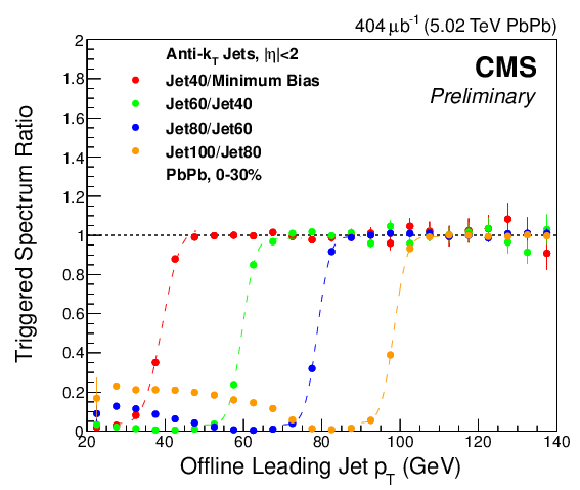
png pdf |
Figure 1-a:
a: ratio of the leading-jet pT distributions in PbPb collisions in the 0-30% centrality bin from various triggers, after the data have been normalized to one another. For better visibility, lines were added to guide the eye. b: contributions from the various jet triggers (colored histograms) to the combined, but otherwise uncorrected, track spectrum (black markers) in the 0-5% centrality bin. |
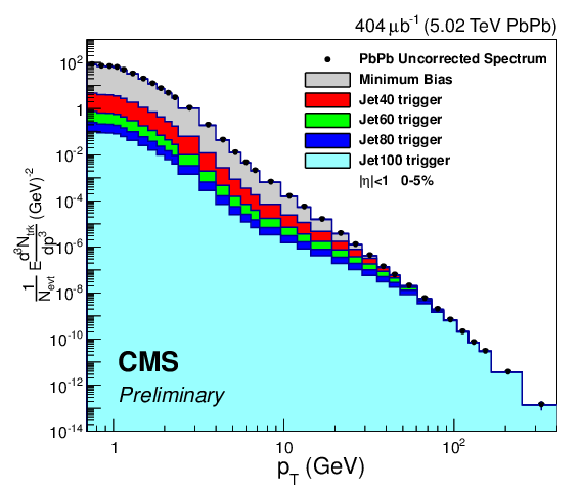
png pdf |
Figure 1-b:
a: ratio of the leading-jet pT distributions in PbPb collisions in the 0-30% centrality bin from various triggers, after the data have been normalized to one another. For better visibility, lines were added to guide the eye. b: contributions from the various jet triggers (colored histograms) to the combined, but otherwise uncorrected, track spectrum (black markers) in the 0-5% centrality bin. |

png pdf |
Figure 2-a:
Charged particle RAA measured in six different centrality ranges in PbPb collisions at √sNN= 5.02 TeV collision energy. The error bars represent the statistical uncertainties, the blue and gray error boxes around 1 show the Glauber-model-related TAA and the pp luminosity uncertainties, respectively, while the yellow band represents all other systematic uncertainties. |

png pdf |
Figure 2-b:
Charged particle RAA measured in six different centrality ranges in PbPb collisions at √sNN= 5.02 TeV collision energy. The error bars represent the statistical uncertainties, the blue and gray error boxes around 1 show the Glauber-model-related TAA and the pp luminosity uncertainties, respectively, while the yellow band represents all other systematic uncertainties. |
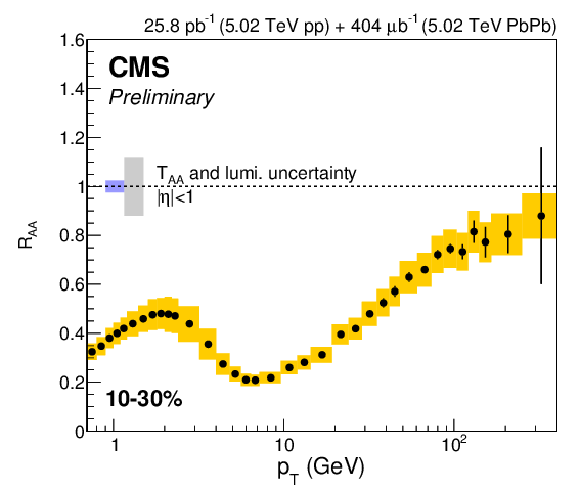
png pdf |
Figure 2-c:
Charged particle RAA measured in six different centrality ranges in PbPb collisions at √sNN= 5.02 TeV collision energy. The error bars represent the statistical uncertainties, the blue and gray error boxes around 1 show the Glauber-model-related TAA and the pp luminosity uncertainties, respectively, while the yellow band represents all other systematic uncertainties. |
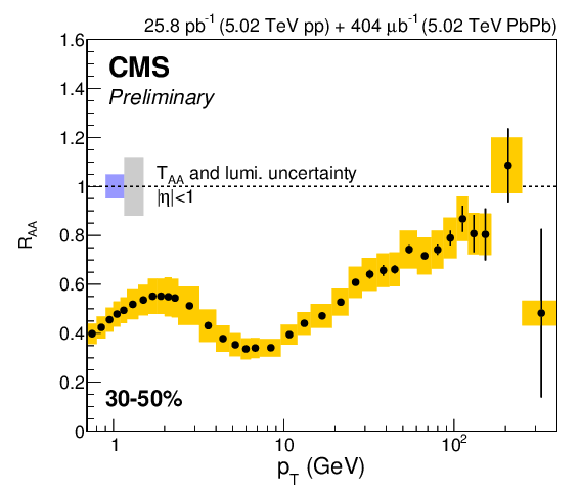
png pdf |
Figure 2-d:
Charged particle RAA measured in six different centrality ranges in PbPb collisions at √sNN= 5.02 TeV collision energy. The error bars represent the statistical uncertainties, the blue and gray error boxes around 1 show the Glauber-model-related TAA and the pp luminosity uncertainties, respectively, while the yellow band represents all other systematic uncertainties. |
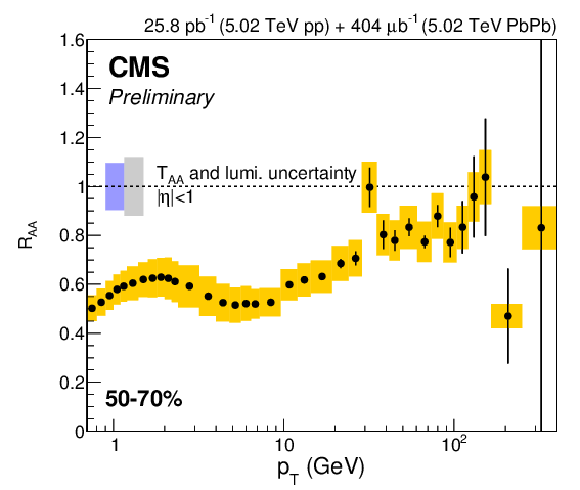
png pdf |
Figure 2-e:
Charged particle RAA measured in six different centrality ranges in PbPb collisions at √sNN= 5.02 TeV collision energy. The error bars represent the statistical uncertainties, the blue and gray error boxes around 1 show the Glauber-model-related TAA and the pp luminosity uncertainties, respectively, while the yellow band represents all other systematic uncertainties. |
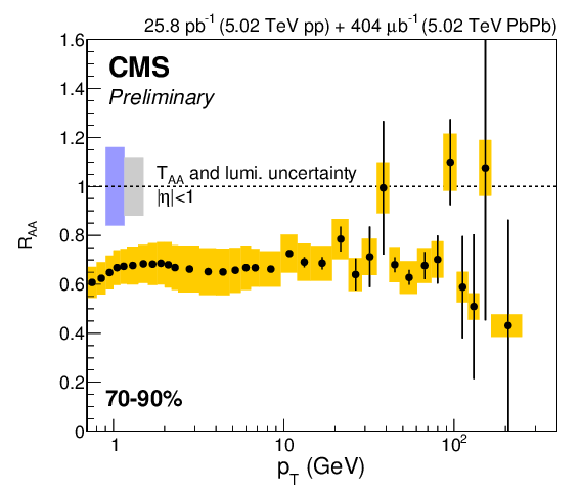
png pdf |
Figure 2-f:
Charged particle RAA measured in six different centrality ranges in PbPb collisions at √sNN= 5.02 TeV collision energy. The error bars represent the statistical uncertainties, the blue and gray error boxes around 1 show the Glauber-model-related TAA and the pp luminosity uncertainties, respectively, while the yellow band represents all other systematic uncertainties. |
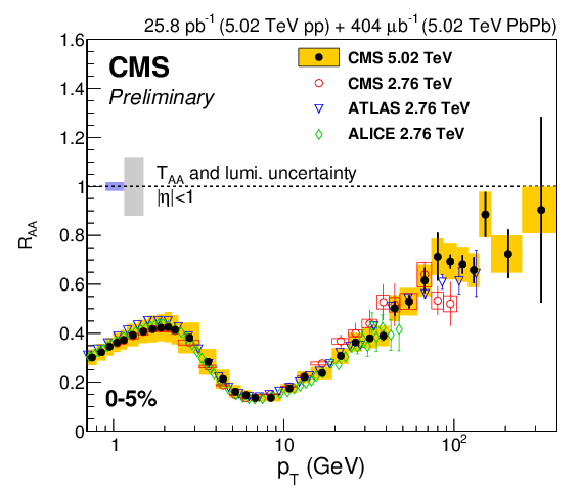
png pdf |
Figure 3-a:
Charged particle RAA measured in six different centrality ranges at √sNN= 5.02 TeV compared to CMS [10] (all centrality bins), ALICE [8] (in the 0-5% and 5-10% centrality bins) and ATLAS [9] (in the 0-5% centrality bin) results at a center-of-mass energy per nucleon pair of 2.76 TeV. |
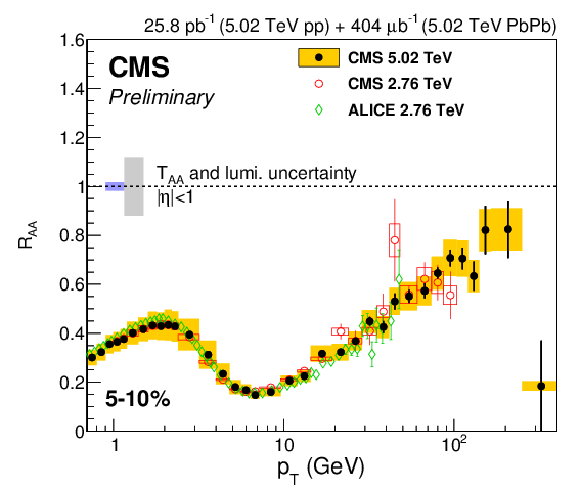
png pdf |
Figure 3-b:
Charged particle RAA measured in six different centrality ranges at √sNN= 5.02 TeV compared to CMS [10] (all centrality bins), ALICE [8] (in the 0-5% and 5-10% centrality bins) and ATLAS [9] (in the 0-5% centrality bin) results at a center-of-mass energy per nucleon pair of 2.76 TeV. |
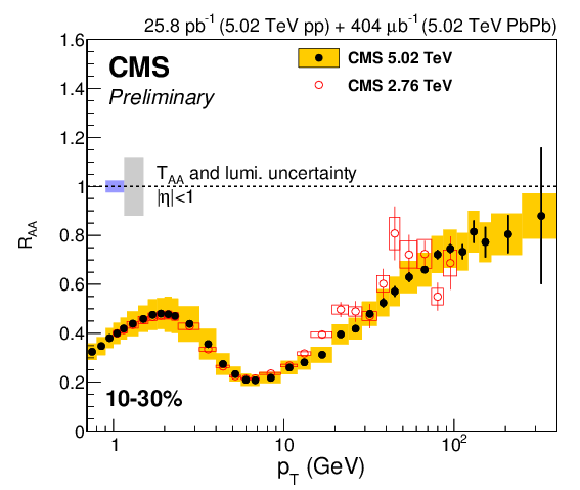
png pdf |
Figure 3-c:
Charged particle RAA measured in six different centrality ranges at √sNN= 5.02 TeV compared to CMS [10] (all centrality bins), ALICE [8] (in the 0-5% and 5-10% centrality bins) and ATLAS [9] (in the 0-5% centrality bin) results at a center-of-mass energy per nucleon pair of 2.76 TeV. |
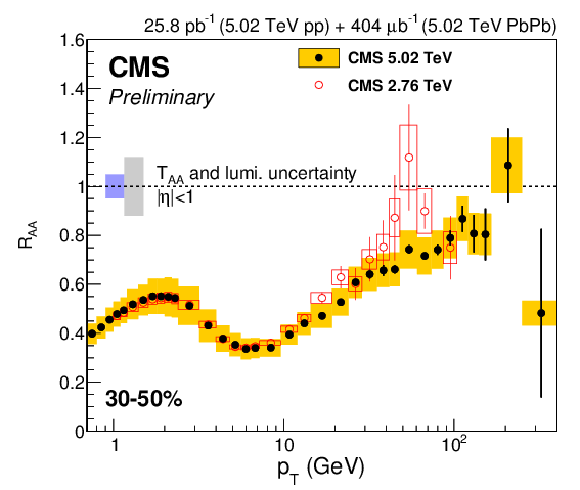
png pdf |
Figure 3-d:
Charged particle RAA measured in six different centrality ranges at √sNN= 5.02 TeV compared to CMS [10] (all centrality bins), ALICE [8] (in the 0-5% and 5-10% centrality bins) and ATLAS [9] (in the 0-5% centrality bin) results at a center-of-mass energy per nucleon pair of 2.76 TeV. |
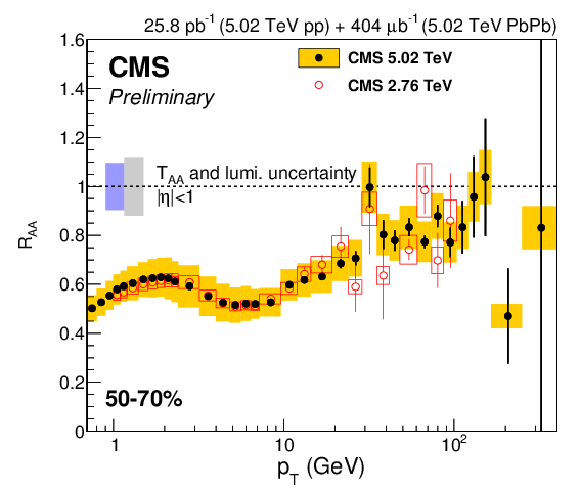
png pdf |
Figure 3-e:
Charged particle RAA measured in six different centrality ranges at √sNN= 5.02 TeV compared to CMS [10] (all centrality bins), ALICE [8] (in the 0-5% and 5-10% centrality bins) and ATLAS [9] (in the 0-5% centrality bin) results at a center-of-mass energy per nucleon pair of 2.76 TeV. |
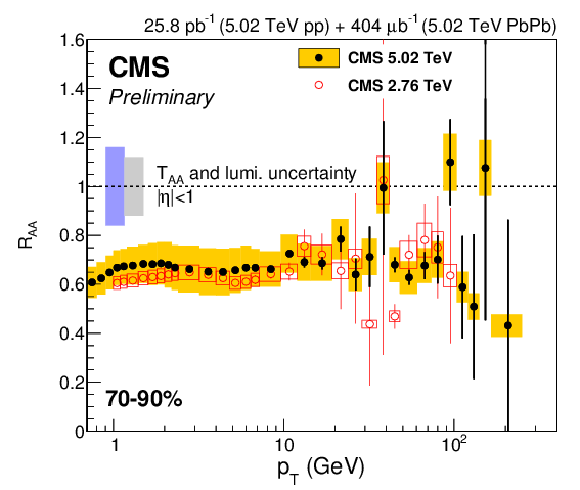
png pdf |
Figure 3-f:
Charged particle RAA measured in six different centrality ranges at √sNN= 5.02 TeV compared to CMS [10] (all centrality bins), ALICE [8] (in the 0-5% and 5-10% centrality bins) and ATLAS [9] (in the 0-5% centrality bin) results at a center-of-mass energy per nucleon pair of 2.76 TeV. |
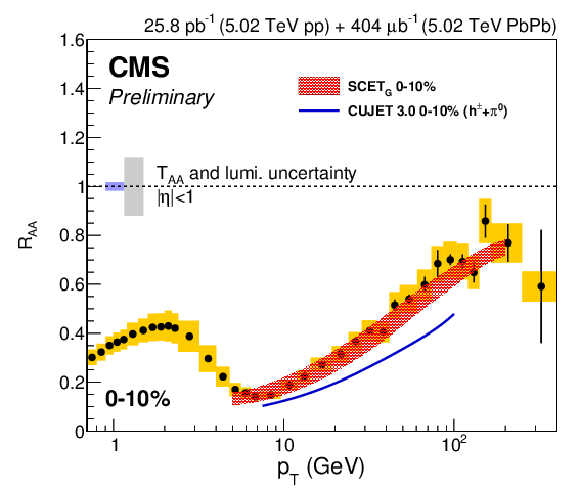
png pdf |
Figure 4-a:
Charged particle RAA measured in the 0-10% (a) and 30-50% (b) centrality ranges at √sNN= 5.02 TeV compared to predictions of models from Refs. [26] and [27]. |
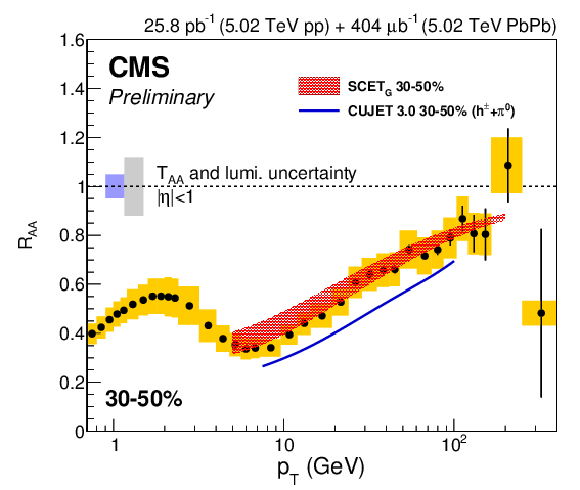
png pdf |
Figure 4-b:
Charged particle RAA measured in the 0-10% (a) and 30-50% (b) centrality ranges at √sNN= 5.02 TeV compared to predictions of models from Refs. [26] and [27]. |

png pdf |
Figure 5:
Measurements of the nuclear modification factors in central heavy-ion collisions at four different center-of-mass energies, for neutral pions (π0) (SPS, RHIC), charged hadrons (h±) (SPS, RHIC), and charged particles (LHC), from Refs. [28-32,8-10], compared to predictions of two models from Refs. [26,27]. The error bars represent the statistical uncertainties. The yellow band around the 5TeV CMS data shows the systematic uncertainties of the measurement, including that of the luminosity. The TAA uncertainties, of the order of ±5%, are not shown. |
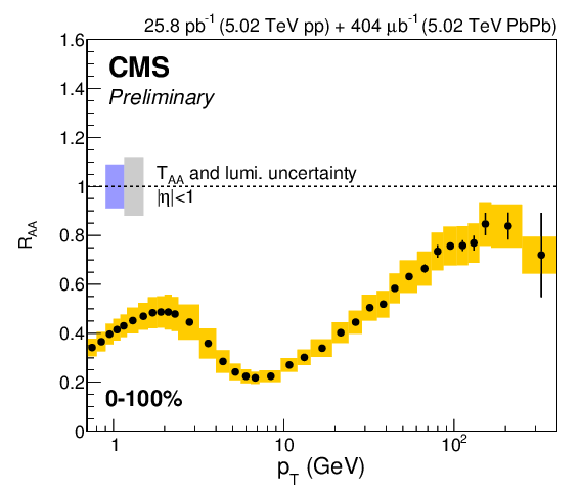
png pdf |
Figure 6:
Charged particle RAA measured in the inclusive 0-100% centrality range in PbPb collisions at √sNN= 5.02 TeV collision energy. The error bars represent the statistical uncertainties, the blue and gray error boxes around unity show the Glauber-model-related TAA and the pp luminosity uncertainties, respectively, while the yellow band represents all other systematic uncertainties. |
| Tables | |
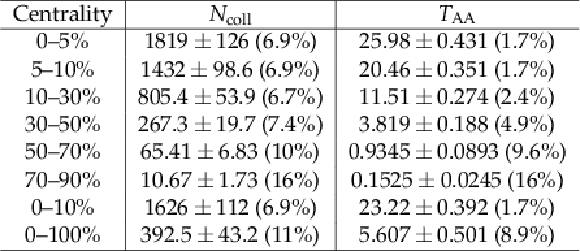
png pdf |
Table 1:
Summary of the Ncoll and TAA values and their uncertainties in √sNN= 5.02 TeV PbPb collisions for the centrality bins used in this report. |
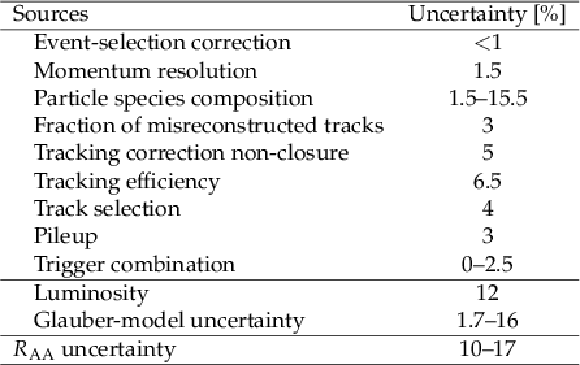
png pdf |
Table 2:
Systematic uncertainties associated with the charged particle RAA measurement. The ranges quoted cover both the pT and the centrality dependence of the uncertainties. The uncertainty of RAA quoted in the table does not include the luminosity and the TAA uncertainties. |
| Summary |
| The presented charged particle RAA distributions help to illuminate the mechanisms for jet quenching and the properties of the medium produced in heavy-ion collisions. Together with measurements on high-pT charged particle azimuthal anisotropies, inclusive jet spectra, fragmentation functions, γ-jet and Z-jet correlations, it constrains the possible phase space of parameters for models aiming to describe the main features of heavy-ion collisions. |
| References | ||||
| 1 | D. d'Enterria | Jet quenching | Landolt-Bornstein 23 (2010) 471 | 0902.2011 |
| 2 | M. L. Miller, K. Reygers, S. J. Sanders, and P. Steinberg | Glauber modeling in high energy nuclear collisions | Ann. Rev. Nucl. Part. Sci. 57 (2007) 205 | nucl-ex/0701025 |
| 3 | B. Alver et al. | Importance of correlations and fluctuations on the initial source eccentricity in high-energy nucleus-nucleus collisions | PRC 77 (2008) 014906 | 0711.3724 |
| 4 | BRAHMS Collaboration | Quark Gluon Plasma an Color Glass Condensate at RHIC? The perspective from the BRAHMS experiment | Nucl. Phys. A 757 (2005) 1 | nucl-ex/0410020 |
| 5 | PHENIX Collaboration | Formation of dense partonic matter in relativistic nucleus nucleus collisions at RHIC: Experimental evaluation by the PHENIX collaboration | Nucl. Phys. A 757 (2005) 184 | nucl-ex/0410003 |
| 6 | STAR Collaboration | Experimental and theoretical challenges in the search for the quark gluon plasma: The STAR collaboration's critical assessment of the evidence from RHIC collisions | Nucl. Phys. A 757 (2005) 102 | nucl-ex/0501009 |
| 7 | B. B. Back et al. | The PHOBOS perspective on discoveries at RHIC | Nucl. Phys. A 757 (2005) 28 | nucl-ex/0410022 |
| 8 | ALICE Collaboration | Centrality Dependence of Charged Particle Production at Large Transverse Momentum in Pb--Pb Collisions at √sNN= 2.76 TeV | PLB 720 (2013) 52 | 1208.2711 |
| 9 | ATLAS Collaboration | Measurement of charged-particle spectra in Pb+Pb collisions at √sNN= 2.76 TeV with the ATLAS detector at the LHC | JHEP 09 (2015) 050 | 1504.04337 |
| 10 | CMS Collaboration | Study of high-pT charged particle suppression in PbPb compared to pp collisions at √sNN= 2.76 TeV | EPJC 72 (2012) 1945 | CMS-HIN-10-005 1202.2554 |
| 11 | CMS Collaboration | The CMS experiment at the CERN LHC | JINST 3 (2008) S08004 | CMS-00-001 |
| 12 | GEANT4 Collaboration | GEANT4: A Simulation toolkit | NIMA 506 (2003) 250 | |
| 13 | M. Cacciari, G. P. Salam, and G. Soyez | The anti-kt jet clustering algorithm | JHEP 04 (2008) 063 | 0802.1189 |
| 14 | O. Kodolova, I. Vardanian, A. Nikitenko, and A. Oulianov | The performance of the jet identification and reconstruction in heavy ions collisions with CMS detector | EPJC 50 (2007) 117 | |
| 15 | CMS Collaboration | Run 2 Upgrades to the CMS Level-1 Calorimeter Trigger | JINST 11 (2016) C01051 | 1511.05855 |
| 16 | T. Sjostrand, S. Mrenna, and P. Z. Skands | A Brief Introduction to PYTHIA 8.1 | CPC 178 (2008) 852 | 0710.3820 |
| 17 | CMS Collaboration | Event generator tunes obtained from underlying event and multiparton scattering measurements | EPJC 76 (2016) 155 | CMS-GEN-14-001 1512.00815 |
| 18 | I. P. Lokhtin and A. M. Snigirev | A Model of jet quenching in ultrarelativistic heavy ion collisions and high-p(T) hadron spectra at RHIC | EPJC 45 (2006) 211 | hep-ph/0506189 |
| 19 | CMS Collaboration | Observation and studies of jet quenching in PbPb collisions at nucleon-nucleon center-of-mass energy = 2.76 TeV | PRC 84 (2011) 024906 | CMS-HIN-10-004 1102.1957 |
| 20 | CMS Collaboration | Measurement of transverse momentum relative to dijet systems in PbPb and pp collisions at √sNN= 2.76 TeV | JHEP 01 (2016) 006 | CMS-HIN-14-010 1509.09029 |
| 21 | CMS Collaboration | Tracking and Vertexing Results from First Collisions | CMS-PAS-PAS-TRK-10-001 | |
| 22 | K. Werner, F.-M. Liu, and T. Pierog | Parton ladder splitting and the rapidity dependence of transverse momentum spectra in deuteron-gold collisions at RHIC | PRC 74 (2006) 044902 | hep-ph/0506232 |
| 23 | T. Pierog et al. | EPOS LHC: Test of collective hadronization with data measured at the CERN Large Hadron Collider | PRC 92 (2015) 034906 | 1306.0121 |
| 24 | CMS Collaboration | Nuclear Effects on the Transverse Momentum Spectra of Charged Particles in pPb Collisions at √sNN= 5.02 TeV | EPJC 75 (2015) 237 | CMS-HIN-12-017 1502.05387 |
| 25 | CMS Collaboration | Measurement of Tracking Efficiency | CMS-PAS-PAS-TRK-10-002 | |
| 26 | Y.-T. Chien et al. | Jet Quenching from QCD Evolution | PRD 93 (2016) 074030 | 1509.02936 |
| 27 | J. Xu, J. Liao, and M. Gyulassy | Bridging Soft-Hard Transport Properties of Quark-Gluon Plasmas with CUJET3.0 | JHEP 02 (2016) 169 | 1508.00552 |
| 28 | WA98 Collaboration | Transverse mass distributions of neutral pions from Pb-208 induced reactions at 158-A-GeV | EPJC 23 (2002) 225 | nucl-ex/0108006 |
| 29 | D. G. d'Enterria | Indications of suppressed high pT hadron production in nucleus - nucleus collisions at CERN-SPS | PLB 596 (2004) 32 | nucl-ex/0403055 |
| 30 | PHENIX Collaboration | Neutral pion production with respect to centrality and reaction plane in Au+Au collisions at √sNN = 200 GeV | PRC 87 (2013) 034911 | 1208.2254 |
| 31 | STAR Collaboration | Transverse momentum and collision energy dependence of high pT hadron suppression in Au+Au collisions at ultrarelativistic energies | PRL 91 (2003) 172302 | nucl-ex/0305015 |
| 32 | NA49 Collaboration | High transverse momentum hadron spectra at √sNN= 17.3 GeV, in Pb+Pb and p+p collisions | PRC 77 (2008) 034906 | 0711.0547 |

|
Compact Muon Solenoid LHC, CERN |

|

|

|

|

|

|